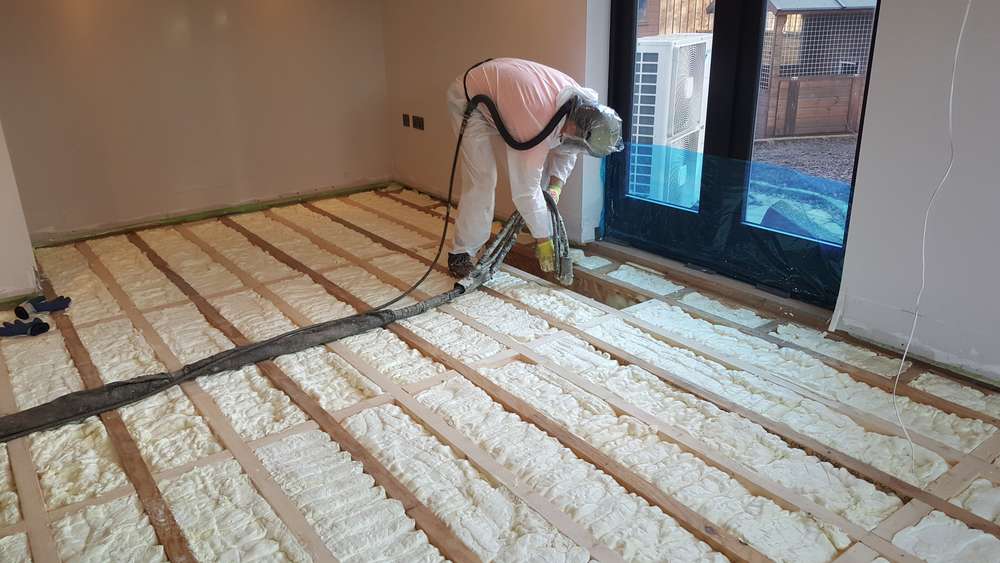Attic Spray Foam Insulation Ballivor
3 Bed Semi Attic Insulation Ballivor

Attic Insulation Ballivor
Spray foam works in many different conditions. Spray foam can be used on roofs, windows and attics as well underfloor heating systems and interior and external walls.
Spray foam insulation is not only warm and comfortable in winter but also cools your home in summer. Spray foam insulation allows the house to breathe because it allows moisture-laden atmosphere to escape through its “Cell” structure.
Benefits of Spray Foam Insulation for your home
Other applications include commercial and industrial buildings, agricultural farm houses, warehouses, commercial and industrial buildings as well as shipping containers, vessels and the refrigeration industry.
It creates an airtight barrier around your home, keeping out rain and cold winds. It allows the heat from your home to escape, which is what most other insulating products today fail to do.


Cost Price Of Spray Foam Insulation
Spray foam insulation is without doubt the most efficient insulating material today. It is more efficient than traditional insulating materials like fiberglass, rock wool and cellulose.
Spray foam insulation also works well as an sound barrier. This reduces outside noise in the home. This is particularly beneficial if the home or business is located near an airport or densely populated city.
Insulate Your Ballivor Property Properly
It’s used to dampen sounds that travel from room to room and across floors between interior walls. It’s especially effective on bathroom walls because noises from flushing toilets or showers can make it a nuisance.
It’s simple to use, and it doesn’t disrupt your everyday activities.
In just one day, you can insulate an Irish home.
The pipes are also protected and insulated to reduce noise.

If you plan on using the loft/attic as storage space, you should lay boards above the joists. The insulation will not be thick enough if it is only between the joists.
It dramatically reduces sound transference when used within walls and attics, roofs, floors and roofs. This is in contrast to fibreglass and rock wool as well as polystyrene and polystyreneboards. Its dense composition and the application process creates an entirely airtight environment. It keeps out sounds from the environment like traffic, pedestrianised streets and homes near airports.
Spray foam insulation also stops sounds from within a structure being transmitted to floors below, above, or into adjacent rooms. Spray foam insulation will dramatically reduce the sound levels of many noises within a structure, including talking, hair dryers (phones), office computers and printers as well as running showers, laundry machines, clothes dryers.
Spray foam insulation is flexible and filled with millions upon millions of microscopic air bubbles. This not only absorbs the vibrations and stops sound from passing through the floor, but also prevents sound from being transferred. Spray foam insulation reduces airborne noise transmission by sealing all cracks and crevices.
Spray foam insulation reduces, if any, the sound of water passing through pipes. The insulation completely surrounds pipes to prevent them from moving and keeps them secure. It eliminates the sound that is made when hot water flows through pipes from heating system. This causes wooded joints to expand, creak, and groan.
It also stops heat from escaping to the upper levels, which makes the lower floors cooler and requires more heat to keep them warm.
If the loft has no condensation or damp problems and is easily accessible, insulation will be very easy.
Uninsulated homes lose 25% of their heat through their roofs. Insulating your attic, loft, or flat roof can reduce heat loss and lower your heating bills.
You can use mineral wool insulation rolls if you have easy access and your loft joists remain regular. The insulation is first laid between horizontal beams called joists. Once that layer has been laid, another layer of mineral wool insulation is added at right angles.
To ensure sufficient insulation, raise the floor height so that you can place enough mineral wool below the new floor. You can either fit timber battens between the joists or buy plastic legs that are specifically designed to fit the joists. To prevent condensation from forming on the boards’ undersides, it is important to ventilate the air gap between insulation and boards.
You should not squash the mineral wool while you place the boards on top. This will decrease its insulation value.
Insulation blocks heat escape from living spaces. Therefore, loft insulation will cool your loft space, which can lead to condensation or damp problems. You may need to increase ventilation if you install loft insulation yourself.
The insulation can be fitted between and over the roofing rafters, which are the flat timbers that support the roof. You have two options: rigid insulation boards that are carefully cut to your specifications or foam insulation spray between the rafters.
Some companies will offer to spray insulation directly on the roof, without having to first fix the problem. We don’t recommend this. It is important to ensure that your roof remains dry before installing insulation.
If you would like to use your loft’s roof space as a heating room, then you should take a different approach and make a separate room.
You will need to insulate the loft walls and ceilings if you intend to use it as your living space.
The air needs to move freely through your house in order to keep it fresh, dry and healthy. Good installers will ensure that there is no obstruction or sealing of any inadvertent ventilation. Do not cover any grilles, vents, or airbricks if you do DIY insulation.
A professional can install blown insulation in a loft that is difficult to reach. They will use special equipment to blow the appropriate insulation material into any space. They may use mineral wool fibres, treated cellulose foam or polyurethane.
Flat roof insulation is a great way to save money on heating, as well as loft insulation. The cost savings will depend on the size of the flat roof.
You can probably insulate your loft yourself if it is accessible and does not have damp problems. For those cases when damp is a problem or a more complex insulation system, professional installation should be done.
Cold draughts could be caused by the cooler loft air. Install an insulated loft hatch to prevent cold draughts.
Insulating your ground-floor is a great idea to keep your property warm and lower your energy bills.
Insulating a loft can be one of the best ways to lower your heating bills, save money on energy and keep your home warm during the winter. Even if you already have insulation, it is crucial to have the best amount in order to make it effective.
Loft floor rolls: These are the most traditional option. They are rolled up along the loft’s ceiling. They are less difficult to lay than insulated boards. They come in both loose and encapsulated (blankets) rolls. These can be used to create base and top layers. To create a storage platform, they can be boarded using stilts.
These are not recommended items or tips that were included in the list of tools and materials. It is important to make sure that you have all the information you need before you start insulation your loft floor.
There may be some insulation in your home, but it may not work well. This could be due to insulation being compressed by storage boards placed over it or if it hasn’t been topped up in the long-term. It is possible for loft floors to be as low as 25mm (deeper) in older properties.
It’s not necessary to remove loft floor insulation. To reach the recommended level, simply add one or more layers to it. You will find more information about the recommended amount in the article.
Your loft floor’s spacings will dictate the width of your roll. This is because insulation is rolled between these joints. We recommend that you choose one that is as close as possible to your joist spacing. This will minimize the need to trim excess.
The insulation’s required thermal resistance. You can also measure the insulation’s thickness using a faster method if you’re only installing loft rolls. You can find more information in the section “How to calculate loft floor insulation thickness”
Areas We Service


Parkhill, Dublin
01 5255297

